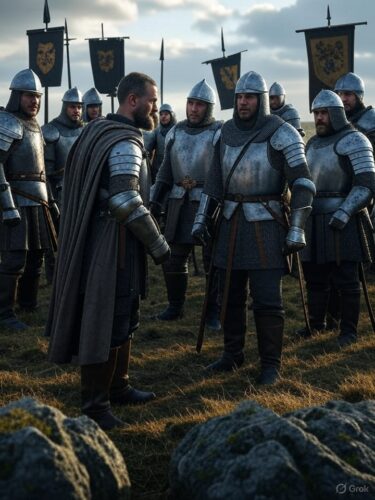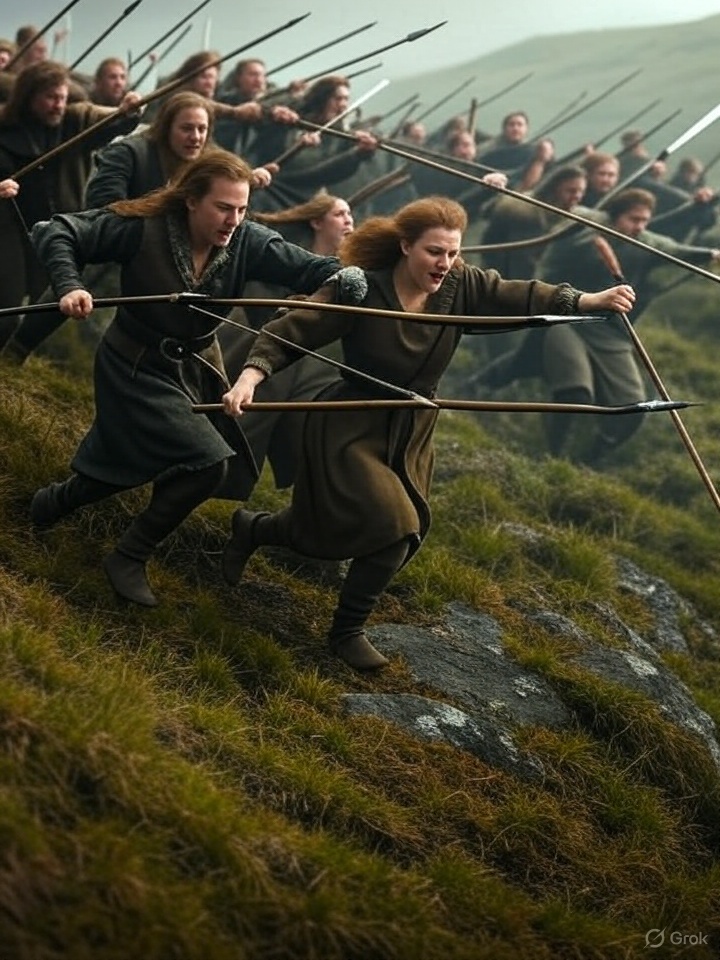**Introduction: A Clash That Echoes Through Time**
On July 19, 1333, the windswept slopes of Halidon Hill, near Berwick-upon-Tweed in northern England, bore witness to a pivotal moment in the Wars of Scottish Independence. The Battle of Halidon Hill was a decisive English victory that reshaped the struggle for Scottish sovereignty and showcased the devastating power of tactical innovation. This often-overlooked clash, overshadowed by more famous battles like Bannockburn, was a masterclass in military strategy and a stark reminder of the resilience required to overcome defeat. In this blog, we’ll delve into the intricate details of this historic event, exploring its causes, unfolding, and consequences with a historian’s zeal. More than that, we’ll draw vibrant lessons from the Scots’ tenacity and the English triumph, offering a practical, motivational plan to apply these insights to modern life. Prepare to be inspired by a 14th-century saga that still speaks to our personal battles today!
**Historical Context: Scotland’s Fight for Freedom**
The early 14th century was a tumultuous period for Scotland. The First War of Scottish Independence (1296–1328) had seen Robert the Bruce secure Scotland’s autonomy with his victory at Bannockburn in 1314. However, peace was fleeting. By 1332, the Second War of Scottish Independence erupted, fueled by competing claims to the Scottish throne and England’s desire to reassert control. Edward Balliol, son of the deposed King John Balliol, sought to reclaim the crown with English backing, challenging the young King David II, son of Robert the Bruce, who was only nine years old and under the guardianship of regents.
England, under King Edward III, saw an opportunity to exploit Scotland’s internal divisions. Edward III, a young but ambitious monarch, was eager to prove his military prowess and restore English dominance in the north. In 1332, Balliol, supported by English forces and a group of nobles known as the “Disinherited” (Scots who had lost lands for supporting England), invaded Scotland and won a surprising victory at Dupplin Moor. This emboldened Edward III to escalate his campaign, leading to the siege of Berwick-upon-Tweed, a strategically vital border town, in early 1333.
The Scots, led by Sir Archibald Douglas, a seasoned commander and guardian of David II, were determined to relieve Berwick and halt English advances. The stage was set for a confrontation that would test both sides’ resolve and ingenuity. The Battle of Halidon Hill was not just a fight for territory but a clash of wills, strategies, and national pride.

**The Battle Unfolds: Tactics and Turmoil**
On July 19, 1333, the two armies met on the slopes of Halidon Hill, a strategic vantage point just north of Berwick. The English, numbering around 10,000 men, held the high ground, a critical advantage. Edward III, advised by experienced commanders like Henry de Beaumont, deployed his forces with meticulous care. The English army was organized into three divisions, or “battles,” with dismounted knights and men-at-arms forming a solid defensive line. Crucially, Edward positioned longbowmen on both flanks, a relatively new tactic that would prove devastating. These archers, wielding powerful longbows capable of firing arrows over 200 yards with lethal accuracy, were England’s secret weapon.
The Scottish army, estimated at 13,000–15,000 men, was larger but less disciplined. Sir Archibald Douglas, aware of Berwick’s dire situation, felt compelled to attack despite the unfavorable terrain. The Scots were organized into three schiltrons—tight, circular formations of spearmen designed to repel cavalry charges. These formations, effective at Bannockburn, were ill-suited for an uphill assault against a prepared enemy. The Scots also lacked significant archery support, relying heavily on infantry and limited cavalry.
As the battle commenced, the Scots advanced up the muddy, rain-soaked slopes of Halidon Hill. The terrain, softened by recent rains, slowed their advance, making them easy targets for the English longbowmen. Arrows rained down in deadly volleys, piercing armor and sowing chaos among the tightly packed schiltrons. The Scots, unable to close the distance quickly, suffered horrific losses before even engaging the English line. When they finally reached the English men-at-arms, their formations were broken, and morale was shattered.
Edward III capitalized on the disarray, ordering his knights to advance. The English cavalry, though limited, flanked the weakened Scottish lines, turning the battle into a rout. Sir Archibald Douglas and many Scottish nobles, including the Earls of Ross, Sutherland, and Menteith, were killed. Estimates suggest the Scots lost 5,000–10,000 men, while English casualties were minimal, likely under 100. The battle was over in a matter of hours, leaving Berwick to fall to the English shortly after.

**Aftermath: A Turning Point in the Wars**
The Battle of Halidon Hill was a crushing defeat for Scotland. The loss of Berwick and the decimation of its leadership weakened the Scottish resistance significantly. Edward Balliol was briefly installed as a puppet king, but his rule was unstable, and David II’s supporters continued to fight. The battle solidified Edward III’s reputation as a formidable military leader and showcased the longbow’s dominance, a tactic that would later define English victories in the Hundred Years’ War, such as at Crécy and Agincourt.
For Scotland, the defeat was a harsh lesson in the dangers of overconfidence and poor tactical choices. Yet, it also galvanized the Scottish spirit. Despite the loss, David II’s forces regrouped, and by 1341, they had regained much of their territory. The resilience of the Scots in the face of such a setback became a hallmark of their national identity, proving that defeat could be a catalyst for renewal.
The battle also had broader implications. It strengthened England’s position in the border regions and set a precedent for the use of combined arms—infantry, archers, and cavalry working in concert. This tactical evolution influenced medieval warfare for centuries, demonstrating the power of adaptability and preparation.

**Why Halidon Hill Matters Today**
While the Battle of Halidon Hill may seem like a distant echo of medieval strife, its lessons are timeless. The English victory was not just a matter of superior numbers or luck but of strategic foresight, adaptability, and leveraging strengths. Conversely, the Scottish defeat highlights the importance of learning from failure, regrouping, and persisting. These principles—preparation, resilience, and adaptability—can transform how we approach challenges in our modern lives, whether in careers, relationships, or personal growth.
Imagine facing a seemingly insurmountable obstacle—a failed project, a career setback, or a personal loss. The Scots at Halidon Hill faced overwhelming odds, yet their story didn’t end there. They adapted, rebuilt, and ultimately prevailed. Similarly, the English victory reminds us that preparation and innovative thinking can turn the tide in our favor. By applying these lessons, we can navigate our own “battles” with courage and clarity.
**A Modern Battle Plan: Applying Halidon Hill’s Lessons**
Here’s a detailed, actionable plan to harness the lessons of Halidon Hill in your daily life. These steps are designed to empower you to face challenges with the strategic mindset of Edward III and the resilience of the Scots.
– **Assess Your Terrain (Preparation):** Just as Edward III chose the high ground, evaluate your environment before tackling a challenge. Research your goals thoroughly—whether it’s a job interview, a new business venture, or a personal project. Identify your strengths (your “longbowmen”) and position them effectively. For example, if you’re preparing for a presentation, practice your delivery and anticipate questions to gain the “high ground” of confidence.
– **Adapt to Challenges (Innovation):** The English longbow was a game-changer because it was used innovatively. In your life, seek new tools or approaches to solve problems. If you’re struggling with productivity, experiment with time-blocking or a new app like Notion. If a relationship is strained, try a fresh communication style, like active listening or writing a heartfelt letter.
– **Learn from Defeat (Resilience):** The Scots didn’t give up after Halidon Hill; they regrouped and fought on. When you face failure, analyze it objectively. Ask: What went wrong? What can I improve? For instance, if you miss a promotion, seek feedback, upskill through online courses, and reapply with renewed focus. Treat setbacks as stepping stones.
– **Build a Support Network (Allies):** The English victory relied on coordinated efforts among knights, archers, and commanders. Surround yourself with mentors, colleagues, or friends who can offer guidance or encouragement. Join a professional network, attend workshops, or connect with a community group to bolster your “army.”
– **Stay Committed to Your Cause (Purpose):** The Scots fought for their independence, a cause greater than themselves. Identify your “why”—the purpose driving your goals. Whether it’s providing for your family, pursuing a passion, or making a difference, let this purpose fuel your persistence. Write it down and revisit it during tough times.
– **Practice Tactical Patience (Timing):** Edward III waited for the Scots to exhaust themselves uphill. In life, timing is critical. Don’t rush into decisions—whether it’s quitting a job or making a big purchase. Take time to gather information and strike when the moment is right, like waiting for a stock market dip to invest.
– **Celebrate Small Victories (Morale):** The English consolidated their win by securing Berwick. Acknowledge your progress, no matter how small. Completed a tough workout? Treat yourself to a favorite meal. Finished a project? Share it with pride. These moments boost morale and keep you motivated.
**Implementing the Plan: A Week-by-Week Guide**
– **Week 1: Map Your Terrain**
Identify one major goal (e.g., a career change, fitness target, or creative project). Spend 30 minutes daily researching the steps needed to achieve it. Create a mind map of resources, skills, and potential obstacles.
– **Week 2: Innovate Your Approach**
Experiment with one new strategy related to your goal. For example, if you’re job hunting, try a new platform like LinkedIn or attend a virtual networking event. Track the results in a journal.
– **Week 3: Reflect on a Setback**
Recall a recent failure and write a 500-word reflection on what you learned. Outline three actionable steps to improve. For instance, if a business pitch failed, refine your pitch deck and practice with a mentor.
– **Week 4: Strengthen Your Network**
Reach out to two people who can support your goal—a colleague, mentor, or friend. Schedule a coffee chat or virtual call to discuss your plans and seek advice. Join an online community related to your field.
– **Ongoing: Revisit Your Purpose**
Create a “purpose statement” (e.g., “I want to become a graphic designer to inspire others through art”). Place it somewhere visible, like your desk or phone wallpaper, and read it daily to stay motivated.

**The Ripple Effect: Why This Matters**
The Battle of Halidon Hill teaches us that victory and defeat are two sides of the same coin—both offer opportunities for growth. By preparing strategically, adapting creatively, and persisting through setbacks, you can turn challenges into triumphs. Imagine the confidence of knowing you can face any obstacle, the thrill of overcoming a hurdle through ingenuity, or the pride of rebuilding after a fall. These are the gifts of Halidon Hill, a battle fought centuries ago that still inspires us to fight for our own dreams.

**Conclusion: Your Hill to Conquer**
The Battle of Halidon Hill, fought on July 19, 1333, was more than a clash of swords and arrows—it was a testament to the power of strategy, the pain of defeat, and the strength to rise again. Its lessons echo across centuries, urging us to prepare diligently, innovate boldly, and persevere relentlessly. As you face your own battles—whether in the boardroom, the gym, or the heart—let the courage of the Scots and the cunning of the English guide you. Your Halidon Hill awaits, not as a place of defeat, but as a summit of triumph. Charge forward, and claim your victory!

